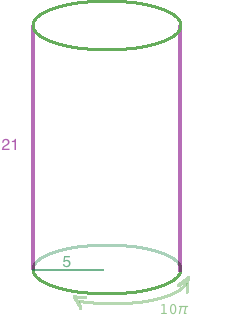
The diameter is 10 inches so the radius is 5 inches.
circumference of base = 2π * (radius) = 2π * (5 inches) = 10π inches
lateral area of cylinder = (circumference of base) * (height) = (10π inches) * (21 inches) = 210π square inches
Assuming that the bottom of the pot is covered and the top of the pot is uncovered, we only need to add the area of one of the bases to the lateral area to find the total covered area. So let's find the area of the base and add one of those to the lateral area.
area of base = π * (radius)2 = π * (5 inches)2 = 25π square inches
So...
total covered area = lateral area of cylinder + area of base
total covered area = 210π square inches + 25π square inches
total covered area = 235π square inches
total covered area ≈ 738.3 square inches